Are your customers getting value out of the online experience you’re offering? Are they satisfied with your products and services? And just how loyal are they to your brand exactly? These are the questions customer feedback will help you get the answers to.
In return, a better understanding of your customers’ needs helps ensure that your efforts are fruitful, from improved customer satisfaction to increased conversion. But how do you get started? And what does the process look like from start to finish? Let’s dive in…
In this post, we will define customer feedback and outline the three management pillars, collecting, analysing and closing the feedback loop. This includes which metrics and digital channels to use and how to bring your feedback program full circle with analytics and closed loop feedback techniques.
What you’ll learn:
- What is customer feedback?
- Why is customer feedback important?
- The customer feedback management process
- How to collect customer feedback (with survey template examples)
- How to analyse customer feedback (with chart examples)
- How to close the loop with customer feedback
- Great customer feedback examples from real brands
What is customer feedback?
Customer feedback is data collected from your customers. It expresses a reaction or opinion of a product, service or the overall experience with your company. Gathering this information can be done physically, with the help of buttons or paper surveys, for example, but also online.
As our society is becoming more digitalised, the need to collect feedback from online channels, like websites, mobile apps and email campaigns, grows. It’s only natural, as many companies nowadays have some sort of online presence.
The insights from the feedback are then used by various roles within a company, such as digital marketers, UX designers, web analysts, mobile marketers and more to improve the customer experience.
As mentioned above, customer feedback can be collected both digitally and physically. However, our expertise lies within the world of digital feedback (as a feedback software company ;)) so this article will particularly focus on managing customer feedback online.
Why is customer feedback important?
It is important to collect customer feedback as it delivers valuable and actionable insights to organisations straight from the source: the customer. These insights do not only reveal areas of improvement on your website, mobile app or within your email campaigns. They also show you how those areas can be improved.
Acting on customer feedback to improve your user experience (UX) can have a positive effect on many parts of your business, like revenue, brand awareness, customer loyalty and much more.
The customer feedback management process
Customer feedback management (CFM) is the process of optimising the online customer experience by:
- Collecting customer feedback
- Analysing the data
- Closing the loop by taking action
In other words, CFM brings feedback full circle. Let’s take a look at how this process works in practice.
1. How to collect customer feedback
There are a variety of channels upon which your organisation can collect feedback. And depending on your goals, there are also several different customer feedback metrics you can measure within your surveys that will give you the insights you need to optimise the online experience.
But before we dive into examples, let’s look at the two different methods for collecting this feedback: active feedback and passive feedback.
Active and passive feedback
Active customer feedback is essentially captured ‘in-the-moment’. This type of feedback survey is company-initiated, meaning that it will appear depending on specific rules (triggers and conditions) set in place by your organisation.
Potential rules include:
- Time on page
- Exit intent
- Scrolling to the end of a page
- … and more!
Passive customer feedback is initiated by the user, for example, clicking a feedback button or leaving a review on Trustpilot. Because it’s user-driven, passive feedback tends to be more general and often highlights issues you weren’t actively asking about, such as bugs, unclear content, or problems with product selection.
Active customer feedback is triggered by specific behaviours, such as exit intent, time on page, or scrolling. These surveys are usually more targeted and help you assess a particular step in the user journey or funnel.
In short:
Passive feedback: broad, ongoing insights into general UX.
Active feedback: focused insights tied to specific moments or goals.
For the best results, combine both approaches across your digital channels. Now let’s look at the main types of customer feedback surveys you can use.
Customer feedback survey examples: Website feedback
Website feedback helps organisations understand which areas of their website are performing well and which areas can be improved upon.
This can include everything from key pages and funnels in the customer journey to online content, such as blogs or videos. As previously mentioned, this type of customer feedback can be collected in a few different ways:
- With the help of a ‘feedback button’ (passive feedback)
- Embedding a survey on your website
- Including a pop-up / slide-in survey, activated by a trigger (active feedback)
Within these surveys, you can choose to gather data for different metrics such as Net Promoter Score (NPS), Goal Completion Rate (GCR), Customer Effort Score (CES) and Customer Satisfaction (CSAT).
NPS
NPS is one of the most popular metrics and is a great way of gauging customer loyalty online. Here is an example of an NPS survey.
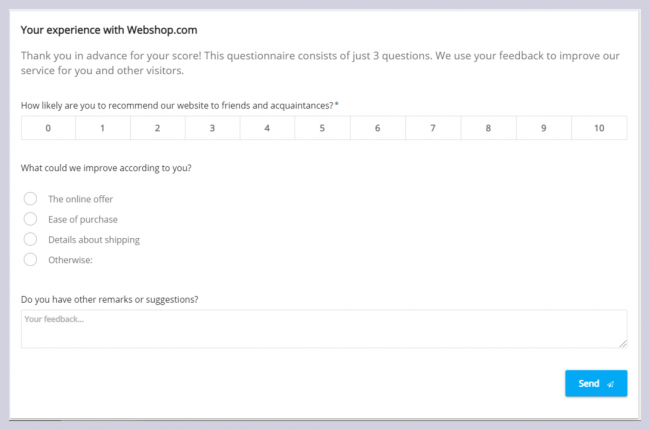
GCR
GCR measures the number of visitors who have completed a specific goal on your website or mobile app.

CES
CES is a metric used to understand how much effort it took your customer to achieve their goal.

CSAT
CSAT is essentially a measurement of how well your website meets the expectations of your customers. Here is an example of a CSAT survey.

Ratings
Ratings can be used to gauge sentiment and general opinions of website visitors. These are typically used in passive feedback surveys.
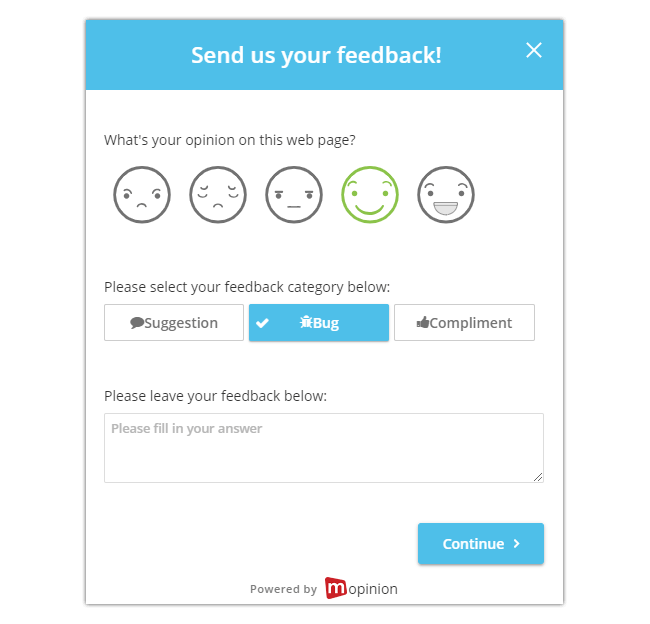
Customer feedback survey examples: Email feedback
Email feedback plays an important role in customer-centricity. This type of customer feedback enables you to provide a platform for two-way communication with your customers. They can share their thoughts and perceptions of your email(s) and the information you’ve provided.
There are various ways your organisation can collect feedback in email campaigns. A common method is to deploy an embedded survey with a ‘thumbs-up’ or ‘thumbs-down’ option.
We often see this type of feedback used in newsletters and service emails, which are typically content-rich.

DHL Email Survey
Additionally, it’s typical for organisations to gather NPS feedback within their emails. Often within a post-purchase email as the recipient has already experienced the customer journey from start to finish.

Customer feedback survey examples: Mobile in-app feedback
As the use of mobile continues to grow, mobile in-app feedback (also referred to as mobile feedback) has become a very powerful and necessary type of feedback.
In fact, there’s an entire movement,‘mobile first’,which is pushing organisations to put more focus on the performance of their mobile apps. Customers have high expectations when it comes to the performance of these apps – that’s why creating a good mobile experience is a must.
Mobile in-app feedback gives organisations the means to gather feedback in a way that is suitable for the channel. After all, a mobile screen is different from a desktop, space is limited and usability is of the utmost importance.
Providing customer feedback should always be a smooth and effortless process, which in this case requires a slightly different approach.
In fact, in addition to mobile-specific targeting techniques, some customer feedback tools even offer solutions that enable users to gather mobile metadata and capture in-app screenshots to better define mobile issues.
Many of the same metrics used for websites can also be used for mobile apps. For example, CSAT, NPS and so on.
Here are a few examples of how these customer feedback surveys might look in-app:
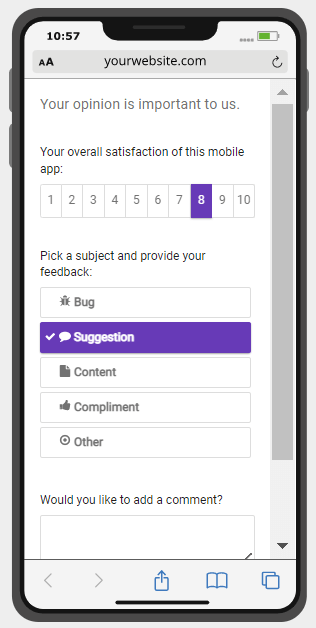
Example of a CSAT in-app survey
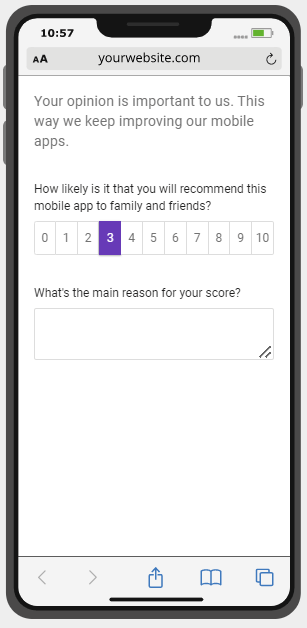
Example of an NPS in-app survey
Try any of these Feedback Form Templates
Online feedback forms are dynamic tools used to capture customer feedback on websites and apps. But what are the best Feedback Form Templates for your website?
2. How to analyse customer feedback
The next step in the customer feedback management process is customer feedback analysis.
Therefore it is important to leverage a feedback tool that offers comprehensive customer feedback analytics. Analysing customer feedback is important for bringing feedback data together and identifying key trends and bottlenecks.
Sure, you can export all of your data to another tool and analyse it there, but that is often time-consuming and cannot be done in real-time.
However, getting started with the analysis process can be a bit tricky and somewhat overwhelming for some organisations.
Where do you start? How should you set up your dashboard for the best results? Which chart-building techniques will help you derive the most relevant insights from your data?
Customer feedback analysis examples
The good news is: there are endless charts you can use to digest all of your feedback data. We’ve listed a few below (which you can find more extensive information on in the article listed above.
Identify trends over time
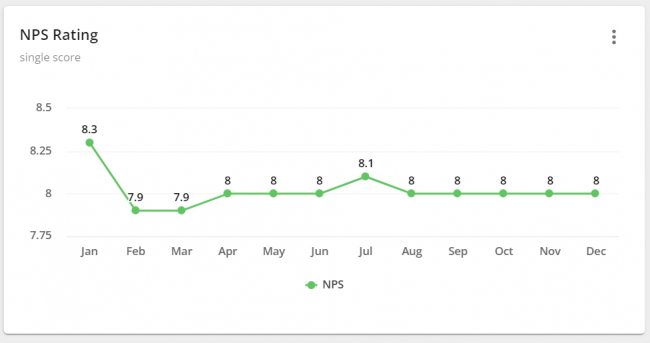
Cross-analyse different channels or even countries

3. How to close the loop with customer feedback
Having gathered and analysed your customer feedback data, the last and final step is to close the loop and bring all of your efforts to a profitable conclusion.
Closed loop feedback is essentially how you can ensure your customers and prospects ultimately buy from you and remain happy, loyal customers.

How to Close the Customer Feedback Loop
Ensure your customers and prospects ultimately remain happy, loyal customers.
First, you’ll need to stay on top of your feedback internally. There are several tools within customer feedback software that enable you to do so, including tagging, assigning feedback items to colleagues and even setting up alerts so that feedback is processed quickly.
These tools help you distribute and manage feedback across multiple departments.

Then you’ll need to revert back to your customers. Try prioritising feedback by implementing timescales. When it comes to online channels, customers generally want a resolution as quickly as possible, so it is advisable to bear this in mind internally.
Track the progress of your actions and revert back to the customer to let them know their feedback is being processed and the team is working on a resolution.
And then, of course, when the issue has been resolved, be sure to notify the customer (or group of customers) depending on how widespread the issue is.
Great customer feedback examples from real brands
Allianz
In this user case we will look at how the organisation Allianz leverages customer feedback.
Note: This is an excerpt from our Customer Stories page. Click the link to read the full Allianz customer story.
Allianz is part of Allianz Group which is one of the largest, multinational financial services companies in the world. At Allianz one of the main principles is that everything must be customer-centric.
This means that Allianz looks at how its customers experience the website early on in the customer journey. Which areas require extra effort? What can be improved upon in order to optimise the customer journey?
Allianz collects customer feedback primarily to discover obstacles within the customer journey. Stefan (Conversion Specialist at Allianz) talks about a challenge Allianz experienced prior to feedback:
There was a tangle of CMSs, tools and (sub) domains and it was therefore impossible to quickly identify when a website was not functioning optimally. Luckily, customer feedback is able to quickly bring this to your attention.
If something does not work, visitors often let us know via the feedback button that is located on every page and a member of the team will receive a notification and start optimising.
Allianz uses both passive and active feedback on the website. Their passive forms enable visitors to let the team at Allianz know what they think of the website.

To prevent drop-offs in conversion, Allianz also collects active feedback via an exit survey. An exit survey is a short questionnaire that asks visitors to share why they are leaving the site or page.
Often this feedback form appears just before someone ‘threatens’ to leave the page and moves the mouse towards the exit, or if someone is on a page for a certain amount of time.
So what kinds of findings did they have?
With one of the insurance policies, Allianz saw that conversion via mobile was low. Many users clicked on the receipt, but were unable to continue. There was no clickable cross or button, so users got stuck and ended up leaving.
As a result of customer feedback, Allianz was able to resolve this issue and conversions increased from 0.48% to 3.50%; an achievement which translated into more than €900,000 in additional premium turnover.
Calvin Klein
In this user case, we will look at how the organisation Calvin Klein leverages customer feedback.
Note: Click the link to read the full Calvin Klein customer story.
Calvin Klein is one of the most recognised fashion houses of today. From a digital perspective, Calvin Klein places a lot of value on data-driven decision-making. They do this by not only monitoring quantitative behavioural data, but also by gathering qualitative insights obtained through listening to their customers.
Davy Schuyt, CRO Manager at Calvin Klein:
People move about the website very differently based on their goals and personal backgrounds, making it increasingly important to be able to ask the right question at the right time. Mopinion allows us to target on a granular level, allowing us to dive deeper into certain topics.
Calvin Klein has multiple surveys running at all times.
“We permanently feature a default feedback button across the website, as well as a permanent survey on the Payment page checking for payment problems (after a set of rules has been met) as well as a survey on the Confirmation page, asking our visitors to recall their shopping experience.”
According to Davy, “the shorter a survey, the more chance someone fills it in. The longer the survey, the more information we get. Generally, we keep the questions to a max of 3, but we always include a field for open input.
It’s important that we can categorise the answers, but more important that people don’t feel like they have to change their opinion to fit a predetermined answer.
As per the activation, we go through our qualitative data sources to ascertain at what point a visitor is most likely to run into an issue that we are trying to solve. That can be on a certain page landing, but also after a certain time, or a certain action taken. That is when we will launch the survey.”
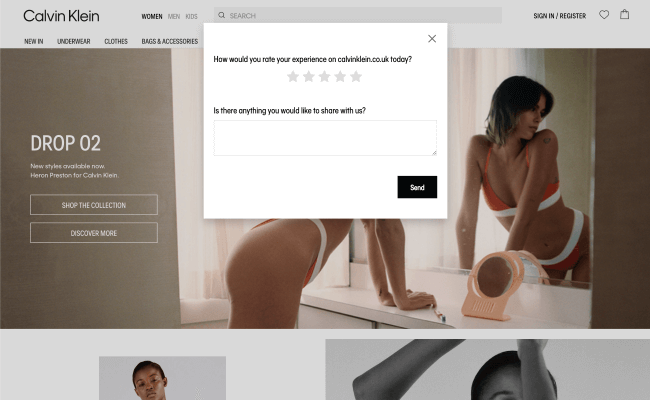
Calvin Klein is very systematic and precise when it comes to analysing their feedback data.
“Every two months we analyse the Confirmation Page, Payment Page and General Feedback surveys. We compare this with previous months to see if persistent errors are diminishing and which new ones are arising. We tend to analyse one-off surveys as soon as possible and use those to fuel our testing roadmap and future campaign implementations.”
All of these are then shared company-wide, since a lot of the learnings are applicable across the board.
Nourish your online experience with customer feedback!
As with many improvement programs, it is critical that you carry out your customer feedback management program from start to finish and do so continuously. This means continuously collecting feedback on all the relevant digital channels, evaluating this feedback in your charts and dashboards and circling back to your customers.
Keep in mind, however, that not all customer feedback tools enable you to easily analyse and take action on your feedback within their software. So make sure you have selected a software that brings your feedback full circle, like Mopinion.
Mopinion is the #1 feedback software for website, mobile app and email feedback. It has an easy-to-use interface, with which users can build, design and configure feedback forms however they like. Mopinion users can also target specific groups of visitors with feedback forms and gain insights into why they are struggling to convert.
Once collected, feedback items can be visualised in customisable dashboards and charts for advanced analyses. Additionally, digital teams can share and take action on these feedback items in a timely manner with the help of smart alerts.
Ready to see Mopinion in action?
Want to learn more about Mopinion’s all-in-1 user feedback platform? Don’t be shy and take our software for a spin! Do you prefer it a bit more personal? Just book a demo. One of our feedback pro’s will guide you through the software and answer any questions you may have.






